Intel's Bean Canyon (NUC8i7BEH) Coffee Lake NUC Review - Ticking the Right Boxes
by Ganesh T S on April 3, 2019 8:00 AM EST- Posted in
- Systems
- Intel
- NUC
- UCFF
- Thunderbolt 3
- Cannon Point
- Coffee Lake-U
GPU Performance - Gaming Workloads
Our gaming test suite (revamped last year) involves six different games:
- Civlization VI (DX12)
- Dota 2
- F1 2017
- Grand Theft Auto V
- Middle Earth: Shadow of War
- Far Cry 5
Most system reviews take a handful of games and process them at one resolution / quality settings for comparison purposes. Recently, we have seen many pre-built systems coming out with varying gaming capabilities. Hence, it has become imperative to give consumers an idea of how a given system performs over a range of resolutions and quality settings for each game. With our latest suite, we are able to address this aspect.
Civilization VI (DX12)
The Civilization series of turn-based strategy games is very popular. For such games, the frame rate is not necessarily an important factor in the gaming experience. However, with Civilization VI, Firaxis has cranked up the visual fidelity to make the game more attractive. As a result, the game can be taxing on the GPU as well as the CPU, particularly in the DirectX 12 mode.
| Civilization VI (DirectX 12) Performance | |||
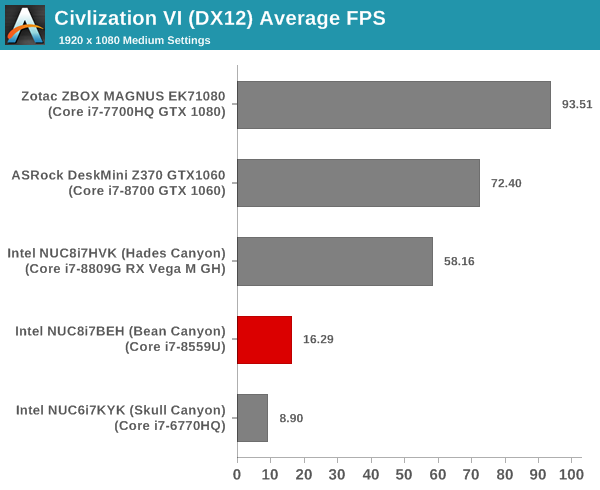
We processed the built-in benchmark at two different resolutions (1080p and 2160p), and with two different quality settings (medium and ultra, with the exact differences detailed here). It is no surprise that the discrete GPU-equipped systems are much further ahead.
Dota 2
Dota 2 has been featuring in our mini-PC and notebook reviews for a few years now, but, it still continues to be a very relevant game. Our evaluation was limited to a custom replay file at 1080p resolution with enthusiast settings ('best-looking' preset). We have now revamped our testing to include multiple resolutions - This brings out the fact that the game is CPU-limited in many configurations.
Dota 2 allows for multiple renderers - we use the DirectX 11 mode. The rendering settings are set to 'enthusiast level' (best-looking, which has all options turned on, and at Ultra level, except for the Shadow Quality set to 'High'). We cycle through different resolutions after setting the monitor resolution to match the desired resolution. The core scripts and replay files are sourced from Jonathan Liebig's original Dota 2 benchmarking instructions which used a sequence of frames from Match 3061101068.
| Dota 2 - Enthusiast Quality Performance | |||
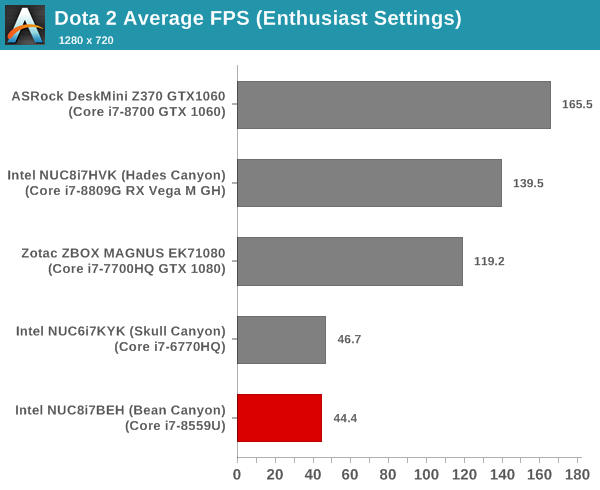
F1 2017
Our gaming system reviews have always had a representative racing game in it. While our previous benchmark suite for PCs featured Dirt 2, we have moved on to the more recent F1 2017 from Codemasters for our revamp.
| F1 2017 - Ultra Quality Performance | |||
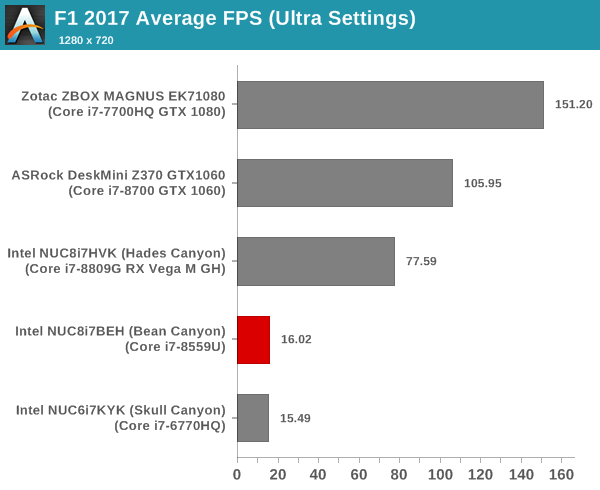
The supplied example benchmark (with some minor tweaks) is processed at four different resolutions while maintaining the graphics settings at the built-in 'Ultra' level. We see the same scenario of the dGPU systems marching well ahead of the Bean Canyon NUC.
Grand Theft Auto V
GTA doesn’t provide graphical presets, but opens up the options to users and extends the boundaries by pushing even the hardest systems to the limit using Rockstar’s Advanced Game Engine under DirectX 11. Whether the user is flying high in the mountains with long draw distances or dealing with assorted trash in the city, when cranked up to maximum it creates stunning visuals but hard work for both the CPU and the GPU. For our test we have scripted a version of the in-game benchmark. The in-game benchmark consists of five scenarios: four short panning shots with varying lighting and weather effects, and a fifth action sequence that lasts around 90 seconds. We use only the final part of the benchmark, which combines a flight scene in a jet followed by an inner city drive-by through several intersections followed by ramming a tanker that explodes, causing other cars to explode as well. This is a mix of distance rendering followed by a detailed near-rendering action sequence.
| Grand Theft Auto V Performance | |||
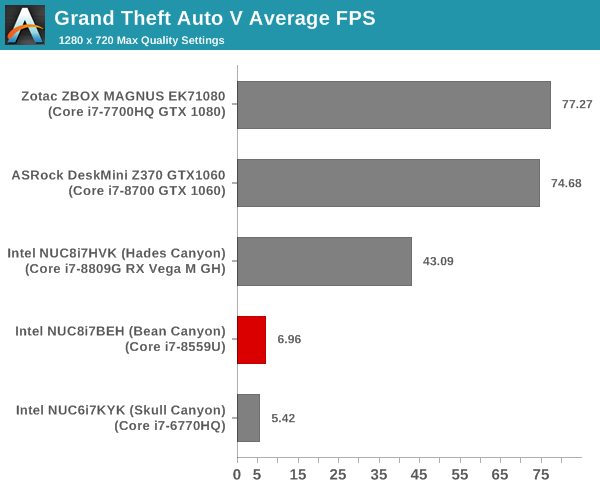
We processed the benchmark across various resolutions and quality settings (detailed here). The results are presented above.
Middle Earth: Shadow of War
Middle Earth: Shadow of War is an action RPG. In our previous gaming benchmarks suite, we used its prequel - Shadow of Mordor. Produced by Monolith and using the new LithTech Firebird engine and numerous detail add-ons, Shadow of War goes for detail and complexity. The graphics settings include standard options such as Graphical Quality, Lighting, Mesh, Motion Blur, Shadow Quality, Textures, Vegetation Range, Depth of Field, Transparency and Tessellation. There are standard presets as well. The game also includes a 'Dynamic Resolution' option that automatically alters graphics quality to hit a pre-set frame rate. We benchmarked the game at four different resolutions - 4K, 1440p, 1080p, and 720p. Two standard presets - Ultra and Medium - were used at each resolution after turning off the dynamic resolution option.
| Middle Earth: Shadow of War Performance | |||
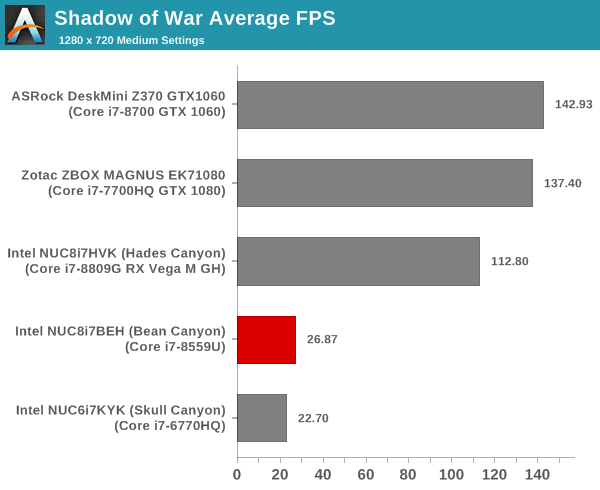
Far Cry 5
Ubisoft's Far Cry 5 is an action-adventure first-person shooter game released in March 2018. The game comes with an in-built benchmark and has standard pre-sets for quality settings. We benchmarked the game at four different resolutions - 720p, 1080p, 1440p, and 2160p. Two preset quality settings were processed at each resolution - normal and ultra.
| Far Cry 5 Performance | |||
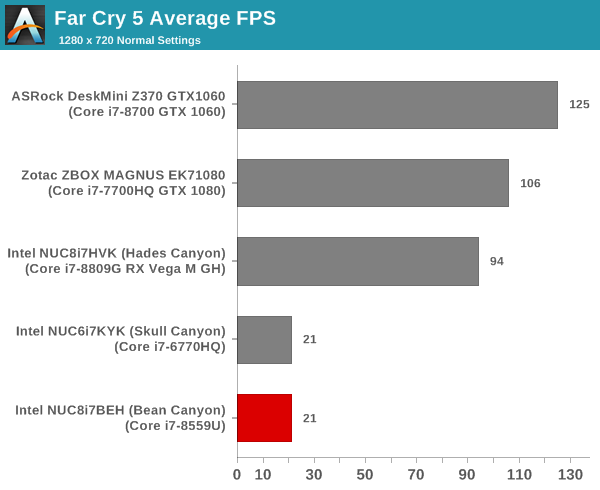
Overall, the Iris Plus Graphics 655 in the Core i7-8559U is a decent upgrade over the Iris Pro Graphics 580 in the Core i7-6770HQ. However, discete GPUs are a must for playable frame rates in any of the games considered above.










81 Comments
View All Comments
jeremyshaw - Wednesday, April 3, 2019 - link
Yeah, I made the mistake of going for an IGP + eGPU setup this time around (X1 Carbon + Lenovo GTX1050 dock). Nevermind the TB3 power issues that Lenovo finally fixed (silently), or GPU driver issues, just the need to lug around another box and its own power brick negates any weight savings over a heavier laptop with even a weak dGPU.This is a mistake I will never, ever make again. The eGPU idea really only works for Mac users, who are "forced" to buy from a range of 4 laptops (5, if you count three year old laptops being sold at full price), of which only one has a dGPU. Another has a passable IGP, that is still weaker than the worse of the current dGPUs (unless if one counts the Lenovo E480's severely throttled RX540). If you are a mac user and intend on staying one, choices are very limited, making eGPUs a necessity for those wanting more power. For anyone else out there, such sacrifices are not necessary.
Death666Angel - Thursday, April 4, 2019 - link
Honestly, the eGPU thing only makes sense to me in one scenario: with a laptop that has an anemic GPU inside (low end AMD/Intel or just integrated) that has great battery life on the go but the owner wants to play some games at home on a larger monitor with good image quality and not have the hassle to maintain two independant systems. So the eGPU enclosure stays in one place, the laptop gets lugged around, is light, long lasting and productive on the go and when you get home, one cable to make it into a decent gaming PC.eGPU on already stationary desktops is just weird (get a slightly bigger case and stick a GPU inside that, more options, probably cheaper as well) and people who lug around the eGPU enclosure and their laptop are also kinda missing the point. If you do that, why not just get a 1060 or 1080 laptop and be done with it? The prices of the whole GPU+enclosure should not be much cheaper than the built in versions and the performance delta is probably negligible compared to the increased ease of use.
flyingpants265 - Wednesday, April 3, 2019 - link
Not sure if I understand these things. ITX is already like 7x7 inches, and supports up to 9900k. Especially with undervolted chips you're looking at under 150 watts.CaedenV - Wednesday, April 3, 2019 - link
I just hope they all come with TPM modules now. The few physical machines we have are Intel NUCs, and in the first batch we bought they didn't have them and I was speechless... I mean, even dirt cheap $300 laptops come with TPMs these days!?! how could a $4-500 machine NOT have it?Then when ordering the next round of devices we found that most of the units available through our vendors did not have them; had to do a special order! This should be a standard feature, not something we have to search out any longer!
Jorgp2 - Wednesday, April 3, 2019 - link
Pretty sure Laptops come with an embedded TPM, which is less secure than a discrete one.Death666Angel - Wednesday, April 3, 2019 - link
"Season 4 Episode 4 of the Netflix Test Patterns title" That's definitely something I had no clue about. :Dimaheadcase - Thursday, April 4, 2019 - link
$963 (as configured, no OS)ok right..
Death666Angel - Thursday, April 4, 2019 - link
That's with a 1TB NVME SSD and 32GB RAM. Look at the base model and configure your own options and see how much it costs then (still not cheap, probably, but not as bad). And compare it to a laptop of similar specs (28W quad core with thunderbolt and eDRAM).mikato - Thursday, April 4, 2019 - link
Yeah it said $503 barebones (need to add memory and storage). I guess you must have to really like that CPU and the case to make that competitive. When I say that, I mean it might be losing the HTPC crowd.mikato - Thursday, April 4, 2019 - link
Actually it's not as bad as I guessed. Here is an alternative-$150 2400G
$120 Mini ITX mobo
$131 In Win Chopin
$401 total. Both would probably be plenty of power for most anyone's HTPC. The 2400G is more power/heat.